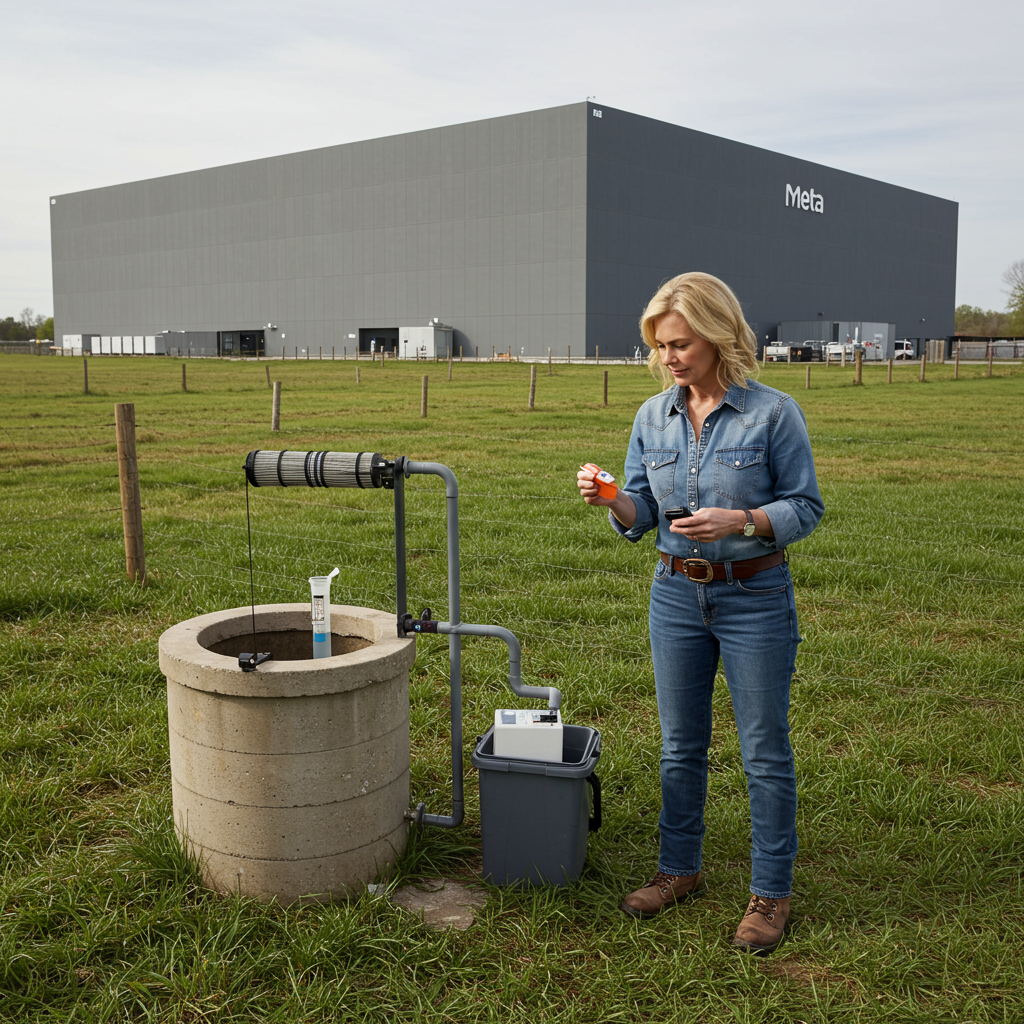Imagine retiring to a peaceful rural haven, only for that dream to crumble when your tap water turns undrinkable. This is the stark reality facing residents like Beverly Morris in Mansfield, Georgia. Her quiet retirement home, nestled just yards from a massive, windowless data center owned by Meta, has become a battleground over basic resources.
Ms. Morris reports that since the data center’s construction, her private well water has suffered from excessive sediment buildup. The problem is so severe she must haul water in buckets simply to flush her toilet. While she managed to restore some kitchen water pressure through repairs, the water from her taps still contains visible residue. “I’m afraid to drink the water,” Morris states, acknowledging she still uses it for cooking and brushing her teeth despite her fears. This deeply personal struggle highlights a growing, national tension: the digital infrastructure powering our lives demands physical resources, sometimes directly impacting nearby communities.
The Physical Thirst of the Digital Cloud
The concept of “the cloud” often feels ethereal and disconnected from the physical world. Yet, this vast digital space exists within tangible buildings filled with humming servers, blinking lights, and complex cooling systems – data centers. These facilities are the backbone of modern digital life, supporting everything from online banking to the burgeoning field of artificial intelligence and tools like ChatGPT.
The explosion in AI development is driving unprecedented growth in data center construction. Experts estimate that AI-driven data centers alone could consume a staggering 1.7 trillion gallons of water globally by 2027. This immense demand stems from the fundamental need to cool powerful, heat-generating processors. Mark Mills of the National Center for Energy Analytics highlights this need, explaining that these “very hot processors” require “a lot of water” for cooling. Many data centers rely on evaporative cooling systems, a process similar to how sweating cools the human body, where water absorbs heat and evaporates. On hot days, a single large facility can use millions of gallons. The scale becomes particularly stark when considering that even a single AI query, such as asking a question to ChatGPT, can require about as much water as a small bottled drink.
From Construction Sites to Community Wells
This rapid expansion of data centers isn’t happening without friction. Local communities across the US are increasingly pushing back. Reports indicate that rising activism has led to $64 billion in data center projects being delayed or blocked nationwide. While concerns often focus on noise, traffic, and energy consumption, water resources have emerged as a major point of contention.
Georgia serves as a prime example of this tension. Its humid climate and relatively abundant water sources make it an attractive location for data center developers seeking cost-effective cooling solutions. However, this perceived abundance comes at a potential cost to local water systems.
Concerns aren’t limited to operational water usage. Construction activities can also have significant environmental impacts. Gordon Rogers, Executive Director of Flint Riverkeeper, a non-profit dedicated to protecting Georgia’s Flint River, points to potential issues downstream from new data center construction sites. Water samples collected by local volunteers near one site appeared cloudy and brown, suggesting possible sediment runoff. This runoff could also contain flocculants, chemicals used in construction to prevent erosion, which can create harmful sludge if they enter waterways. While companies like QTS, building the facility near the sampled creek, state their centers meet high environmental standards and bring tax revenue, local residents argue they are left to deal with the immediate consequences of construction activities often carried out by third-party contractors. Rogers emphasizes the principle that a wealthier property owner should not have greater rights than a smaller, less wealthy neighbor.
A Nation Under Strain: The Broader Water Crisis
The strain data centers place on water resources occurs within a broader context of existing challenges facing US water infrastructure and access. Millions of Americans already struggle with reliable access to safe drinking water. A study published in Risk Analysis highlighted that approximately 2 million people in the U.S. lack basic running water services, and another 30 million rely on drinking water systems that violate safety rules.
This study identified significant concentrations of public water system violations in states like West Virginia, Pennsylvania, North Carolina, and Oklahoma. Wyoming County, West Virginia, ranked highest for violations within a single system. The research also introduced the concept of “water injustice,” defined as unequal access to safe water that disproportionately impacts low-income households and people of color. Hotspots for water injustice were found primarily in Mississippi, South Dakota, and Texas.
While this research didn’t directly link these widespread violations to data centers, it underscores the fragility of existing water systems in many parts of the country. Adding large-scale industrial water demands, such as those from data centers, places additional pressure on resources and infrastructure that are, in many areas, already struggling with quality, access, and equity issues. The debate around privatizing water systems as a potential solution was also explored in the study, which concluded that privatization alone isn’t sufficient; local context, regulatory effectiveness, and community vulnerability play crucial roles.
The Tech Industry Responds: Progress or Promises?
Acknowledging the growing concerns, tech giants state they are working to mitigate their environmental footprint, including water usage. Amazon Web Services (AWS), which operates more data centers globally than any other company, has set a goal to be “water positive” by 2030. Will Hewes, AWS’s global water stewardship lead, explains this means aiming to return more water to watersheds and communities where they operate than they consume.
AWS is reportedly investing in various initiatives, including leak detection and repair, rainwater harvesting, and using treated wastewater for cooling purposes. In some regions, like Virginia, they are partnering with local groups, such as farmers, to reduce nutrient pollution in bodies of water like the Chesapeake Bay. In areas where water isn’t used for cooling, such as South Africa and India, AWS still invests in local water access and quality projects. Hewes notes that in the Americas, AWS typically uses water for cooling on only about 10% of the hottest days each year, but the cumulative effect of many facilities remains significant.
The Path Forward: Sustainability Meets Necessity
Professor Rajiv Garg, who teaches cloud computing at Emory University, sees data centers as an indispensable part of the future. He describes them as the “backbone of modern life,” asserting that “there’s no turning back” from our reliance on this infrastructure.
However, Garg argues that the path forward must prioritize sustainability. This involves investing in smarter cooling systems, implementing rainwater harvesting, and developing more efficient infrastructure. While acknowledging that the short-term expansion will create a “huge strain” on resources, he believes the industry is beginning a necessary shift towards more sustainable practices. Data centers are also becoming a focus of national policy, highlighted by discussions around building extensive AI infrastructure powered by American data.
The contrast between essential technological advancement and immediate environmental impact is clear. For residents in places like Georgia, where the humid climate attracts developers seeking water for cooling, the future of tech is already a tangible reality. It’s a reality that is often loud, resource-intensive, and challenging to live next to, underscoring the critical challenge: how to power tomorrow’s digital world without depleting the most fundamental resource of all – clean water.
Frequently Asked Questions
Why do data centers require vast amounts of water?
Data centers use large quantities of water primarily for cooling the powerful servers that generate significant heat. Many facilities use evaporative cooling systems, where water absorbs heat and then evaporates, similar to how human sweat cools the body. This process is highly effective but requires a continuous water supply, consuming millions of gallons daily in large centers, especially on hot days.
What steps are tech companies taking to reduce data center water use?
Major tech companies operating data centers are investing in various sustainability initiatives. These include developing and implementing more efficient cooling technologies, utilizing treated wastewater instead of potable water, implementing rainwater harvesting systems, and focusing on leak detection and repair within their operations. Some companies also invest in local water stewardship projects outside their direct consumption.
How do data centers impact local water resources and communities?
Data centers can impact local water resources in several ways. Their large operational water demands can strain local supplies, particularly in areas already facing scarcity or infrastructure challenges. Additionally, the construction of these large facilities can lead to issues like sediment runoff and potential chemical contamination in nearby waterways, as highlighted by concerns raised by residents and environmental groups near construction sites. These impacts can directly affect the water quality and availability for nearby residents, potentially disrupting private wells.



